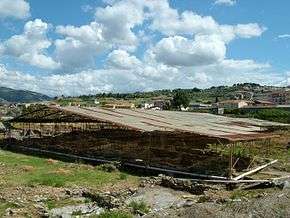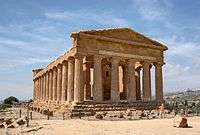Villa Romana di Patti
 The archaeological site of the villa | |
 Shown within Italy | |
| Location | Patti, Italy |
|---|---|
| Region | Sicily |
| Coordinates | 38°8′57″N 14°58′19″E / 38.14917°N 14.97194°ECoordinates: 38°8′57″N 14°58′19″E / 38.14917°N 14.97194°E |
| Type | Dwelling |
| History | |
| Founded | 4th century BCE |
| Abandoned | Approximately 400 CE |
| Periods | Roman Imperial |
| Cultures | Roman |
| Site notes | |
| Condition | Ruined |
| Ownership | Public |
| Management | Soprintendenza per i Beni Culturali ed Ambientali di Messina |
The Villa Romana di Patti is a Roman villa located in the comune of Patti in the province of Messina on Sicily. It was the seat of a latifundium.
History and description
The villa was discovered in 1973 during construction work on a stretch of the A20 motorway, when two pillars destroyed part of the north side of the villa. Although the excavation is still ongoing and many rooms still need to be dug up at floor level, the general configuration of the villa is already quite clear.
The nucleus of the villa consists of a peristyle in the center which is surrounded by the residential area of the villa. Typical of the late Roman villa, the most representative rooms are the Aula Absidata ("apse hall") which opens to the center of the west wing and a triconch in the southern wing where the peristyle overlooks the sea. The Aula Absidata contained a mosaic floor which was destroyed, but the mosaic floors of the peristyle and triconch are in excellent condition.
The mosaic of the peristyle consists of a grid of square panels inserted in a frame of continuous laurel wreathes enriched with floral and ornamental motifs. The mosaic of the triconch includes octagonal and circular medallions with animals on curvilinear sides. The quality of both polychrome mosaics is not very high, which indicates they were the product of a Sicilian workshop instead of North African craftsmen.
The villa was constructed in the fourth century BCE and destroyed by a violent earthquake around 400 CE. More research is needed to define the chronology of the villa more precisely.
Further reading
- Sfameni, Carla (2004). "Residential Villas in Late Antique Italiy: Continuity and Change". In Bowden, William; Lavan, Luke; Machado, Carlos. Recent Research on the Late Antique Countryside. Late Antique Archaeology. 2. Leiden: Brill. pp. 335–375. ISBN 9789004136076.
- Voza, Giuseppe (1982). "Le ville romane del Tellaro e di Patti in Sicilia e il problema dei rapporti con l'Africa". 150-Jahr-Feier Deutsches Archäologisches Institut Rom: Ansprachen und Vorträge, 4–7 Dezember 1979. Mitteilungen des Deutschen Archäologischen Instituts - Römische Abteilung (in Italian). 25. Mainz: Philipp von Zabern. pp. 202–209. ISBN 3805305583.

